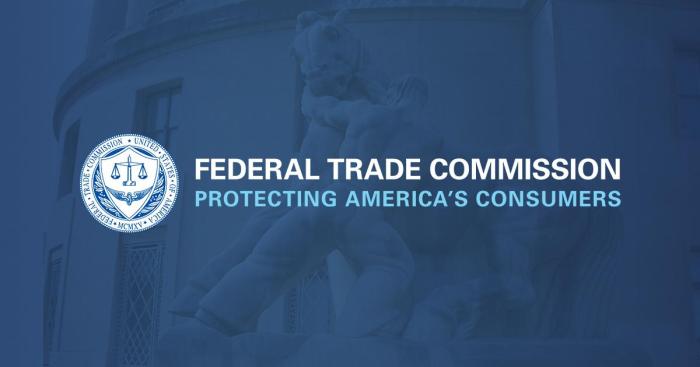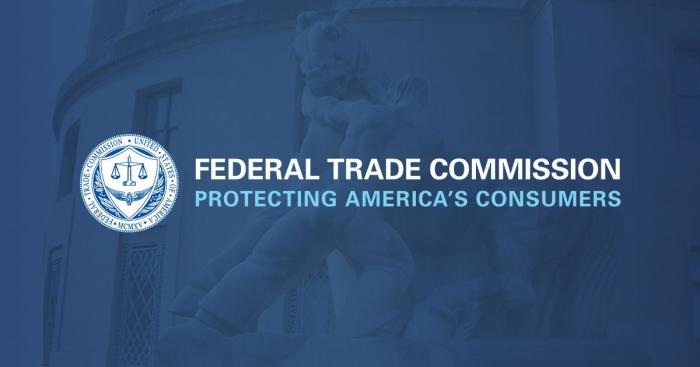The FTC is stepping up its fight against fake AI promises and scams, aiming to protect consumers from fraudulent schemes leveraging the hype surrounding artificial intelligence. This initiative tackles a growing problem, where individuals and companies are making false claims about AI capabilities to lure in unsuspecting victims. The FTC’s actions highlight their commitment to consumer protection in the face of these increasingly sophisticated scams.
This article explores the FTC’s strategy, examining the types of AI scams, their impact on consumers, and the proactive measures the FTC is taking to prevent further harm. It also delves into the future of AI-related fraud, highlighting the evolving landscape and the challenges the FTC faces in maintaining consumer trust in this rapidly changing technology.
Background of FTC Action
The Federal Trade Commission (FTC) is stepping up its efforts to combat the proliferation of fraudulent AI promises and scams targeting consumers. This proactive stance reflects a growing recognition of the need for robust consumer protection in the rapidly evolving landscape of artificial intelligence. The FTC’s history of tackling deceptive marketing practices extends to many sectors, and the emergence of AI-related scams necessitates a similar, swift response.The rise of AI has created a fertile ground for fraudsters to exploit consumer trust and financial vulnerabilities.
These scams often leverage the mystique and potential of AI to deceive consumers into purchasing products or services that don’t deliver on their promises, or even worse, are outright scams. The FTC’s role in protecting consumers from these deceptive practices is crucial in maintaining market integrity and fostering consumer confidence in the emerging AI sector.
Historical Overview of FTC Enforcement Actions
The FTC has a long history of addressing deceptive advertising and marketing schemes. While AI-specific scams are a more recent phenomenon, the underlying principles of consumer protection remain constant. The FTC’s approach involves investigating complaints, analyzing marketing materials, and taking legal action against companies found to be misleading consumers. This process often involves settlements where companies agree to cease and desist from certain practices.
Evolution of AI-Related Scams
Early AI-related scams often focused on the promise of quick wealth through AI-powered investment schemes or exaggerated claims about AI-powered tools. As AI technology advanced and became more accessible, the sophistication of scams increased. This evolution mirrored the broader trend in online fraud, with criminals adapting their tactics to exploit emerging technologies and vulnerabilities.
Examples of FTC Settlements and Lawsuits
Several instances of FTC settlements and lawsuits against companies making false AI promises demonstrate the commission’s commitment to protecting consumers. These cases often involved companies claiming their products or services possessed AI capabilities exceeding their actual performance. These cases highlight the importance of verifying claims and assessing the validity of AI-related product offerings.
Table: Key Dates, Types of Scams, and FTC Responses
| Date | Type of Scam | FTC Response |
|---|---|---|
| 2023 | AI-powered investment schemes promising unrealistic returns | FTC issued warning letters and initiated investigations; several companies settled, agreeing to cease misleading advertising. |
| 2022 | AI-powered job-finding apps promising guaranteed employment | FTC conducted outreach to consumers; issued public warnings; several companies agreed to modify their claims. |
| 2021 | AI-powered personal assistants that could not perform as advertised | FTC filed lawsuits against companies; consumers received refunds in some cases. |
Types of AI Scams Targeted
The Federal Trade Commission (FTC) is stepping up its efforts to combat the growing tide of fraudulent AI promises and scams. These schemes prey on consumers’ hopes for a better future, promising quick riches or revolutionary technologies through AI, often concealing misleading or outright false claims. Understanding the various types of AI scams is crucial for consumers to protect themselves from falling victim.These fraudulent schemes are designed to exploit the public’s fascination and growing interest in artificial intelligence.
Scammers capitalize on this interest by crafting deceptive narratives that promise unrealistic benefits or capabilities, luring individuals into investing their hard-earned money in schemes with little to no chance of return.
Categories of Fraudulent AI Promises
AI scams manifest in various forms, each designed to deceive consumers in different ways. These scams often target specific desires, exploiting the allure of financial gain or technological advancement.
- AI-powered investment schemes: These scams promise astronomical returns on investment through AI-driven trading or investment platforms. They often feature testimonials or fabricated data to support their claims, while the underlying algorithms are often non-existent or manipulated for profit.
- AI-generated content services: Scammers may offer services for generating high-quality content (like articles, videos, or images) using AI, but the quality is often subpar, or the software may not be real. This includes claims of AI-powered content creation tools, that are not as advertised.
- AI-powered job opportunities: These schemes may lure job seekers with AI-related roles or remote work opportunities, demanding upfront payments for training or access to the alleged platform. These roles often involve fraudulent promises of high-paying jobs that may not be genuine.
- AI-related software or tools: These scams often involve the sale of fraudulent software or tools, often with inflated claims about AI capabilities, such as the ability to predict the future. Consumers may find that the tools are useless or do not perform as advertised.
Common Themes in AI Scams
Many AI scams share similar themes that prey on consumer psychology. These themes often center on promises of quick riches, unrealistic AI capabilities, and a sense of urgency.
- Promises of quick riches: A common theme is the promise of easy and significant financial gains, often within a short timeframe. This taps into the desire for immediate financial improvement.
- Unrealistic AI capabilities: Scammers often exaggerate or fabricate AI capabilities, promising solutions to complex problems or the ability to perform tasks beyond the current state of AI technology.
- Sense of urgency: A sense of urgency is often created to pressure potential victims into making quick decisions, preventing them from carefully considering the risks involved.
Methods Used to Promote AI Scams
Scammers leverage various methods to promote their fraudulent AI promises. Social media platforms and online advertisements are frequently used to reach a broad audience.
- Social media: Social media platforms are often used to disseminate misleading information and spread fraudulent claims about AI-related opportunities. Fake profiles and testimonials are frequently used to bolster these claims.
- Online advertisements: Online advertisements, including targeted ads, are frequently used to reach specific demographics interested in AI technologies. These ads often contain exaggerated claims and misleading information.
Comparison of AI-Related Scams
The table below summarizes various AI-related scams and the deceptive tactics employed.
The FTC is cracking down on those shady AI promises and scams, which is a good thing. It’s important to be aware of these, especially when it comes to the latest hype surrounding things like the new barbie movie corvette hummer ev forza horizon 5 game and similar products. These seemingly legitimate products are often misleading, and this FTC action is crucial to protect consumers from being taken advantage of.
So, be cautious, do your research, and don’t fall for the hype.
| Type of Scam | Deceptive Tactics | Examples |
|---|---|---|
| AI-powered investment schemes | Promises of high returns, fabricated data, lack of transparency | “Guaranteed” AI-driven trading platforms, unrealistic investment projections |
| AI-generated content services | Claims of high-quality AI-generated content, poor or nonexistent AI technology | AI writing tools with inflated capabilities, misleading testimonials |
| AI-related job opportunities | Demanding upfront payments for training or access, vague job descriptions | “Remote AI analyst” positions requiring initial payments |
| AI-powered software or tools | Exaggerated AI capabilities, lack of functionality, fraudulent pricing | AI tools claiming revolutionary abilities but lacking in practical application |
Impact on Consumers
The rise of artificial intelligence (AI) has brought unprecedented opportunities, but it has also created fertile ground for scams. These fraudulent schemes prey on consumers’ hopes and aspirations, often promising unrealistic returns or extraordinary abilities. The consequences of falling victim to these scams can be devastating, impacting not only finances but also emotional well-being.These AI scams are designed to exploit the public’s growing interest and excitement surrounding AI technology.
They often leverage sophisticated marketing techniques and convincing narratives, making them particularly effective at deceiving individuals and families. Understanding the potential harm is crucial to preventing further exploitation.
Financial Harm
Misinformation and false promises are central to AI scams. These scams can result in substantial financial losses for victims. Individuals might be persuaded to invest in non-existent AI-powered ventures, or they might be tricked into purchasing overpriced or useless AI products. Such scams often lead to the depletion of savings, impacting daily living expenses.
Emotional Harm
The emotional toll of AI scams can be significant. The loss of money can trigger feelings of anger, frustration, and betrayal. Victims may experience a decline in self-confidence and trust, making it difficult to engage in future financial decisions. The disappointment and distress can extend to family members, creating tension and stress within relationships.
Examples of Impact on Individuals and Families
Numerous examples highlight the diverse ways these scams can impact individuals and families. A retiree, excited by the promise of high-return AI investments, might lose their life savings, leading to financial hardship and a loss of security in their golden years. A young family, lured by a purported AI-powered educational tool, might find themselves saddled with unnecessary expenses and a diminished ability to invest in their children’s future.
Hypothetical Scenario: The AI-Powered “Dream Home” Scam
Imagine a social media campaign promoting an “AI-powered dream home” design tool. The campaign boasts features that automatically generate custom home designs based on user input and preferences, guaranteeing a perfect home for a fraction of the usual cost. Enticed by the promise of a personalized and affordable dream home, a couple invests a significant sum in the purported software.
The FTC is cracking down on those shady AI promises and scams, which is definitely a good thing. Thinking about all the food waste we generate during the holidays, especially around Christmas dinner, really makes you think about our impact on the planet. Check out this great article on food waste holidays climate change Christmas dinner to learn more about reducing our footprint.
It’s clear that combating these fake AI schemes is crucial, just as reducing waste is crucial to a sustainable future.
However, the software is unusable and does not generate the promised designs. The couple loses their investment, experiencing significant financial hardship and disappointment in their pursuit of homeownership. The emotional toll of wasted effort and lost resources further impacts their well-being and trust in online promises.
Exploitation of Vulnerable Populations
AI scams often target vulnerable populations, exploiting their anxieties, hopes, and limited access to information. Elderly individuals, for instance, might be more susceptible to promises of guaranteed returns or quick solutions to financial challenges. This vulnerability makes them more susceptible to the allure of fraudulent schemes. Additionally, individuals with limited technical literacy may find it harder to discern legitimate AI ventures from fraudulent ones, further exacerbating the problem.
FTC’s Strategies and Tactics
The Federal Trade Commission (FTC) is actively taking a multi-pronged approach to combatting fraudulent AI promises and scams. Their efforts aim to protect consumers from misleading claims and financial losses, emphasizing education and robust enforcement mechanisms. This proactive stance is crucial in the rapidly evolving AI landscape, where the potential for scams is significant.The FTC’s strategies encompass a range of actions, from issuing warnings and educating consumers about the red flags of AI scams to pursuing legal action against companies making false claims.
Their focus is on holding accountable those who exploit the public’s interest in artificial intelligence for fraudulent gain.
Enforcement Actions
The FTC employs a variety of enforcement actions to target companies and individuals making false or misleading claims about AI. These actions range from cease and desist orders, which compel companies to stop deceptive practices, to civil penalties, which impose financial sanctions for violations. These actions aim to deter fraudulent activities and provide redress for harmed consumers. For example, companies claiming to offer AI-powered investment strategies without proper regulatory approvals may face cease and desist orders, while those falsely advertising AI-powered medical devices might be subject to civil penalties.
Strategies for Combating AI Scams
The FTC employs a variety of strategies to combat AI scams. These strategies include proactive outreach to potential victims, providing educational resources to consumers, and partnering with other agencies and organizations to share information and best practices. These strategies aim to prevent scams from occurring in the first place.
- Public Awareness Campaigns: The FTC actively engages in public awareness campaigns to educate consumers about the characteristics of AI scams. These campaigns often highlight the common red flags that consumers should watch out for. For example, promises of unrealistic returns from AI-powered investment tools or AI-powered medical cures without scientific validation are frequently identified as red flags.
- Collaboration with Industry Partners: The FTC collaborates with technology companies, financial institutions, and other stakeholders to establish best practices for AI development and deployment. This cooperation facilitates a shared understanding of the potential for fraudulent activity.
- Industry-Specific Guidelines: The FTC often provides industry-specific guidelines for businesses operating in the AI sector. These guidelines help ensure that companies are complying with relevant regulations and are not making misleading claims. For example, guidelines for AI-powered investment platforms might emphasize the importance of disclosing risks and fees.
Utilizing Technology for Detection and Investigation
The FTC leverages advanced technologies to detect and investigate AI scams. These technologies can help identify patterns and trends in fraudulent activity, enabling proactive enforcement actions.
- Data Analysis: The FTC analyzes data from various sources, including consumer complaints, online reviews, and social media posts, to identify potential AI scams. This data-driven approach allows the FTC to identify common themes and tactics used by scammers.
- AI Tools: The FTC is exploring the use of AI tools to identify and analyze large volumes of data related to AI scams. These tools can help expedite the detection process and identify emerging trends in fraudulent activity.
Consumer Reporting Mechanisms
Consumer reporting mechanisms play a vital role in the FTC’s efforts to combat AI scams. These mechanisms allow consumers to report suspected fraudulent activities, providing valuable information and contributing to the overall enforcement strategy.
- Complaint Filings: Consumers can file complaints with the FTC about suspected AI scams. These complaints are crucial in identifying patterns, trends, and specific tactics used by scammers. By aggregating these complaints, the FTC can understand the scope and nature of the problem.
- Collaboration with Other Agencies: The FTC works with other agencies, such as state attorneys general and law enforcement, to share information and collaborate on investigations. This cooperation enhances the effectiveness of enforcement efforts.
FTC Tools and Strategies Table
| FTC Tool/Strategy | Description | Example |
|---|---|---|
| Public Awareness Campaigns | Educating consumers about AI scams. | Social media campaigns highlighting red flags. |
| Cease and Desist Orders | Compelling companies to stop deceptive practices. | Ordering a company to remove false AI claims from their website. |
| Civil Penalties | Imposing financial sanctions for violations. | Fining a company for making fraudulent AI claims. |
| Data Analysis | Identifying patterns in fraudulent activity. | Analyzing consumer complaints to find common themes. |
| Consumer Reporting Mechanisms | Allowing consumers to report AI scams. | Filing a complaint with the FTC. |
Prevention and Education: The Ftc Is Stepping Up Its Fight Against Fake Ai Promises And Scams
The FTC’s fight against AI scams requires a proactive approach from consumers. Arming yourself with knowledge and critical thinking skills is paramount in navigating the increasingly complex world of artificial intelligence. Understanding the tactics employed by scammers is crucial in avoiding becoming a victim.Staying informed and skeptical is essential to avoid being misled by inflated promises or deceptive practices.
By developing a healthy dose of skepticism, consumers can protect themselves from financial loss and maintain trust in legitimate AI innovations.
Recognizing Red Flags in AI Scams
AI scams often rely on exploiting consumer desires and anxieties. Identifying common red flags is a key defense mechanism. These red flags can appear in various forms, from online advertisements to unsolicited emails.
- Unrealistic promises: Be wary of claims that guarantee extraordinary results or rapid wealth through AI. AI is a powerful tool, but it doesn’t work miracles overnight.
- Lack of transparency: Scammers often hide details about the AI technology, the company behind it, or the specific process used. Legitimate AI companies are transparent about their technology and procedures.
- High-pressure sales tactics: If a sales pitch feels overly aggressive or rushed, it’s a sign to proceed with caution. Genuine opportunities are presented in a measured, informative manner.
- Suspicious website or email: Examine the website’s design and domain name carefully. Look for inconsistencies or poor grammar. A scam website may use a similar, but not identical, domain name to a legitimate one, or use poor grammar in an email.
- Request for upfront payment: Legitimate AI services typically require payment after the service is delivered, not before. Be wary of offers demanding upfront investments.
Verifying AI Claims
When encountering AI-related products or services, it’s crucial to verify the claims made. This involves conducting thorough research and seeking out independent validation.
- Independent verification: Don’t rely solely on the seller’s claims. Look for reviews from reputable sources, articles from credible news outlets, or independent analyses that assess the technology.
- Checking for certifications: Legitimate AI products and companies may have certifications from industry bodies or recognized organizations that validate their technology.
- Background checks: Investigate the company behind the AI product. Look for a strong history of responsible practices and reliable references.
- Researching similar products: Compare the offered AI product with similar offerings in the market. Assess the price and quality in relation to competitors.
Importance of Critical Thinking
Critical thinking is essential in navigating the digital landscape. Develop a healthy skepticism and question the claims made by AI promoters.
“Don’t be afraid to question claims and seek independent verification.”
- Questioning assumptions: Don’t accept information at face value. Always ask yourself if the claims are logical and plausible.
- Considering alternatives: Explore different explanations for the AI’s performance or the company’s promises.
- Consulting experts: If uncertain, seek guidance from experts in the field of AI or from trusted advisors.
Resources for Consumers
The FTC and other consumer protection agencies provide valuable resources to help consumers identify and report AI scams.
- FTC website: The FTC website offers comprehensive information about AI scams, including warnings, reports, and resources for consumers.
- Consumer protection agencies: Contact your local or national consumer protection agency for assistance.
- Online forums and communities: Engage with online forums or communities dedicated to AI technology. This can provide insights and experiences from other users.
Infographic: Warning Signs of AI Scams
(A simple infographic would visually summarize the key warning signs discussed above, such as unrealistic promises, lack of transparency, high-pressure sales, suspicious websites, and requests for upfront payment.)
Future Trends and Challenges
The fight against AI-related scams is a dynamic one, constantly evolving with advancements in technology. The FTC’s efforts to protect consumers from these scams must adapt to these changes, anticipating new methods of deception. Emerging trends in AI are creating new opportunities for fraudsters, and the FTC needs to stay ahead of the curve to maintain its effectiveness.The FTC’s mission is not just to react to scams; it must proactively identify potential vulnerabilities and develop strategies to address them before they become widespread.
This requires a deep understanding of emerging technologies, including AI, and the creative ways fraudsters can exploit them.
The FTC is cracking down on those misleading AI promises and scams, which is a smart move. It’s interesting to see how this relates to Google’s recent decision to remove the “Share Apps” and “Nearby Share” features from the Play Store; google ditches share apps nearby share play store This might signal a broader effort to combat the spread of potentially harmful or deceptive apps.
Ultimately, the FTC’s proactive approach is crucial in protecting consumers from being duped by false AI claims.
Emerging Trends in AI-Related Scams, The ftc is stepping up its fight against fake ai promises and scams
AI-powered impersonation scams are on the rise. Sophisticated deepfakes, utilizing AI to create realistic but fraudulent video and audio recordings, are becoming more prevalent. These deepfakes can be used to impersonate trusted individuals, making scams appear authentic and more convincing. Additionally, AI-generated synthetic content is being employed in phishing campaigns, creating highly personalized and targeted attacks. This personalization makes these attacks harder to detect and more effective.
The ability of AI to mimic human characteristics is making it increasingly difficult to discern genuine interactions from fraudulent ones.
Challenges the FTC Faces in Combating Evolving Scams
The speed of technological advancement in AI presents a significant challenge for the FTC. Keeping pace with the development of new AI techniques and their potential applications in scams requires significant resources and expertise. Furthermore, the lack of standardized regulations and guidelines for AI development and deployment creates uncertainty for the FTC in establishing clear enforcement actions. The complex nature of AI systems and the difficulty in tracing their origin and use further complicate the investigation process.
Another challenge is the rapid dissemination of AI-generated content through various online platforms, which makes it difficult to monitor and control the spread of fraudulent activities.
Potential Solutions for Addressing These Challenges
Collaboration with tech companies is crucial. The FTC needs to work with developers and platforms to establish clear guidelines and protocols for preventing AI-generated scams. This includes developing AI detection tools and implementing mechanisms to flag potentially fraudulent content. Further, investment in AI-related research and development is essential to stay ahead of emerging threats. This investment would allow the FTC to develop more effective detection tools and strategies for responding to AI-generated scams.
Potential Impact of AI on Future Fraud Prevention Efforts
AI can be a powerful tool for combating fraud. Machine learning algorithms can analyze large datasets of fraudulent activities to identify patterns and predict potential scams. AI can be used to enhance existing fraud detection systems, allowing for faster identification and response to emerging threats. Moreover, AI can help in educating consumers about various types of AI-related scams and help them recognize fraudulent activities.
This proactive approach can greatly improve consumer protection.
Forecast of Potential Future AI-Related Scams and Required Response
| Potential Future AI-Related Scam | Required Response from the FTC |
|---|---|
| AI-generated phishing emails and messages using deepfakes of celebrities or public figures | Develop strategies to identify and flag deepfake content. Partner with social media platforms and email providers to remove such content promptly. |
| AI-powered synthetic content used to create fake online reviews or product information | Collaborate with e-commerce platforms to implement AI-powered tools to detect and remove fraudulent reviews. |
| AI-generated impersonation scams targeting financial institutions or online accounts | Promote awareness campaigns focusing on the signs of AI-related scams. Provide resources for consumers to verify the authenticity of interactions. |
| AI-generated scams using personalized and targeted social media advertisements | Work with social media companies to establish clear guidelines for AI-generated advertisements. Invest in developing tools to detect and filter such ads based on patterns and suspicious activity. |
Legal and Regulatory Framework

The FTC’s intensified efforts to combat AI scams highlight a critical need for a robust legal framework capable of addressing the rapidly evolving landscape of artificial intelligence. Existing consumer protection laws often struggle to keep pace with the innovative, and sometimes deceptive, applications of AI. This necessitates a careful examination of existing legal tools and a proactive approach to developing new regulations tailored to the specific challenges posed by AI-driven fraud.The current legal landscape regarding AI and consumer protection is complex and fragmented.
Existing laws, designed for pre-AI technologies, are often insufficient to address the unique challenges posed by AI-generated content and sophisticated AI-driven scams. This necessitates adaptation and expansion of existing frameworks, particularly those concerning false advertising, unfair business practices, and intellectual property rights.
Current Legal Landscape
Current consumer protection laws, like the Federal Trade Commission Act, provide some basis for addressing AI scams. However, the specific application of these laws to AI-generated content and AI-driven deception is often unclear. The lack of specific provisions for AI-related misrepresentations and the evolving nature of AI technologies create significant gaps in existing regulatory frameworks.
Adapting Existing Laws
Amendments to existing consumer protection laws are necessary to explicitly address AI-related claims. This includes provisions for verifying the authenticity and source of AI-generated content, prohibiting deceptive AI-driven marketing campaigns, and defining clear liability for businesses employing AI in their operations. For instance, laws could require companies to disclose when AI is used in product recommendations or advertising, making consumers aware of the automated nature of the process.
This transparency is essential to combatting misleading AI claims.
International Approaches to AI Regulation
Different countries are taking varying approaches to regulating AI-related claims. Some countries, like the European Union, have established more comprehensive frameworks for AI development and deployment, including provisions for ethical considerations and data privacy. Others are focusing on specific applications of AI, like autonomous vehicles or medical AI. The EU’s emphasis on transparency and user rights contrasts with approaches in other jurisdictions, which might prioritize economic growth or innovation over consumer protection.
This divergence underscores the need for international cooperation.
Importance of International Cooperation
International cooperation is crucial in addressing AI-related scams. Global standards and harmonized regulations would create a consistent and effective framework to combat these scams across borders. Shared best practices, information-sharing mechanisms, and collaborative enforcement efforts among international regulatory bodies are vital to effectively deter and prosecute AI-related fraud. This approach would be crucial in combating AI-based scams that often operate across international boundaries.
Role of Legal Authorities
Legal authorities, such as the FTC, play a critical role in combating AI scams. These authorities must develop expertise in AI technologies and their applications to identify and prosecute AI-related fraud effectively. They must also collaborate with industry stakeholders to establish guidelines and best practices for responsible AI development and deployment. The FTC’s recent actions exemplify this commitment to using existing legal tools and adapting them to the emerging challenges of AI.
This proactive approach is vital to protecting consumers from the rapidly expanding range of AI-related scams.
Summary

In conclusion, the FTC’s intensified efforts against AI scams are crucial for safeguarding consumers from financial and emotional harm. By understanding the various types of scams, recognizing warning signs, and practicing critical thinking, consumers can protect themselves. The FTC’s proactive approach, combined with public awareness and education, is essential to combatting this emerging threat. The future of AI-related fraud prevention requires continued vigilance, collaboration, and innovative solutions from both the regulatory bodies and the public.





